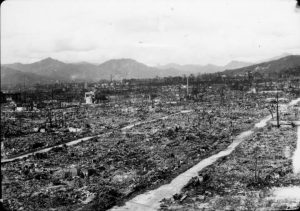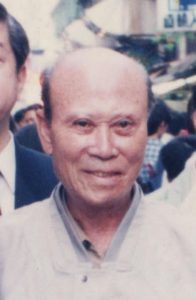Documenting Hiroshima of 1945: End of December, tragedy of having to hide even the name of one’s own country
Dec. 30, 2024
Korean A-bomb survivor returns home
by Maho Yamamoto, Staff Writer
At the end of December 1945, Shin Yong-su, 26 at the time, returned to what is now South Korea. Mr. Shin, who died in 1999 at the age of 80, had been drafted into the military and sent to Hiroshima, where he experienced the atomic bombing. He had no family in Japan and was treated with contempt there, suffering both physically and psychologically.
He returned to his birthplace and hometown of Pyeongtaek City, located in the northwestern part of the country. In the bombing, he had suffered burns over his face and neck and had lost his left ear. His parents wept bitterly when they saw him.
Mr. Shin had been working for a pharmaceutical company before being drafted and sent to Hiroshima in 1942 to work for an affiliated company designated by the military. On August 6, 1945, he was waiting at a streetcar stop in the area of Nobori-cho (in Hiroshima’s present-day Naka Ward) to go to work. There, he was exposed to the flash from the atomic bombing. While slipping in and out of consciousness, he was taken to Ninoshima Island (now in the city’s Minami Ward) and then to a hospital.
With a persistently high fever, and the wounded around him dying one after the other, Mr. Shin felt as if he were barely alive. Discharged from the hospital shortly after the Pacific theater of World War II had concluded, he headed for the village of Yahata (in Hiroshima’s present-day Saeki Ward), where the family of a managing director of the company at which he worked and with whom he was on good terms had a rental home.
When Mr. Shin boarded a streetcar shirtless and enduring hunger, other passengers on the same streetcar showered him with cruel words. “Wow, he stinks. He’d be better off dead.” He moved on to a relief station in the town of Hatsukaichi-cho (present-day Hatsukaichi City) to recover from his wounds and ultimately managed to return to his country.
“I was burned by the flash of the atomic bombing and desperately tried to crawl out from the valley of death. In such circumstances, I was devastated not just by the horror of the atomic bombing but also by how human beings can have disdain for other people and the tragedy of having to hide the name of one’s own homeland,” Mr. Shin wrote in a publication titled Hibaku Chosen/Kankokujin no Shogen (in English, ‘Testimonies of North and South Korean A-bomb survivors’), published in 1982.
Back home, he worked as a farmer with his parents and older and younger brothers as well as experienced the Korean War. He came to know other Koreans who had traveled to Japan from the Korean Peninsula due to hardship, the military draft or conscription, and experienced the atomic bombs. Many suffered from the aftereffects of exposure to A-bomb radiation, poverty, and discrimination, and died without ever receiving adequate medical treatment.
Mr. Shin demanded compensation from the Japanese government for Koreans who had returned to their country after the war. In 1967, he formed the Association for the Relief of Korean Atomic Bomb Victims (present-day South Korean Atomic Bomb Sufferers Association) alongside Kwak Kwi Hoon and others, ultimately being appointed as the organization’s chair. In 1970, he visited Hiroshima and conveyed the reality of the conditions of A-bomb survivors living in South Korea. In 1974, he underwent surgery to remove keloid scar tissue and became the first Korean A-bomb survivor living in South Korea to receive an Atomic Bomb Survivor’s Certificate.
“Each of us, in our true selves, stand closely united and hope to use our remaining strength to restore our dignity as humans and achieve independence,” he wrote in the same publication. His campaign over many years led to the beginning of support for A-bomb survivors living overseas.
His oldest son, Shin Hyung-Keun, 70, served as the consul general of South Korea in Hiroshima City during the period 2011–2014. “History forced my father to suffer a truly awful fate. When I thought about what my father went through, [Hiroshima] also became a painful place,” he said. He came to terms with what his father experienced through encounters with his father’s friends and supporters.
Although many Koreans were killed in the atomic bombing, the overall picture of the damages is still unknown today, 79 years after the bombing.
(Originally published on December 30, 2024)









